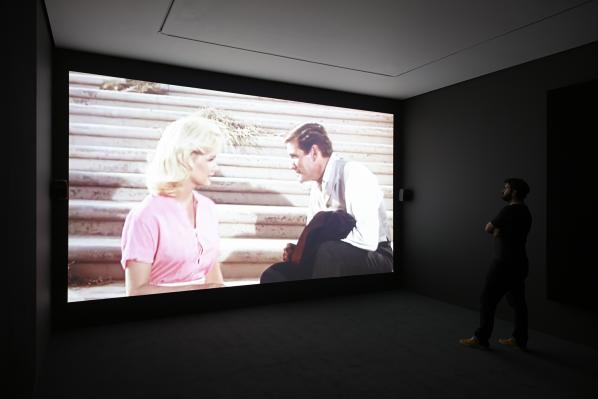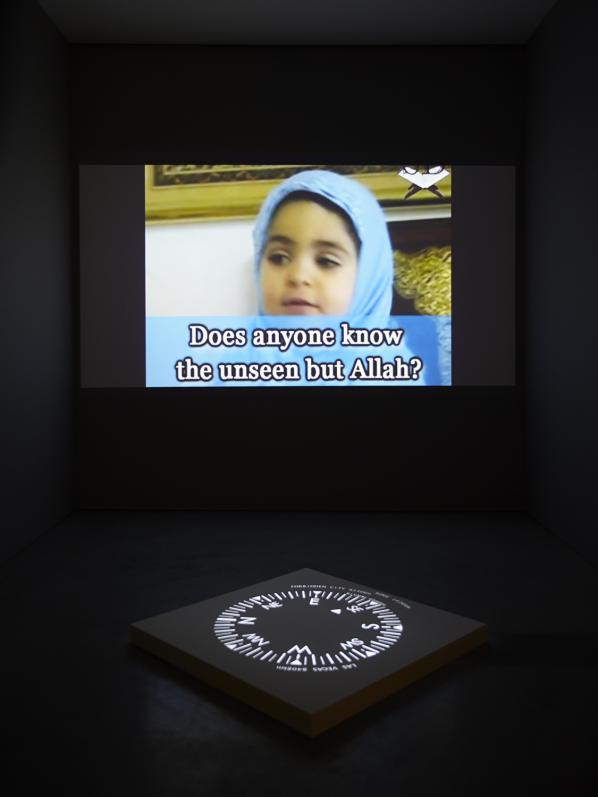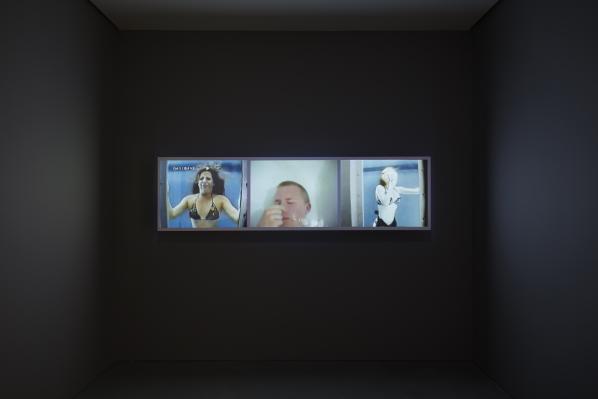



Featured image: Thomson and Craighead, Here (2013)
Visiting Jon Thomson and Alison Craighead’s survey exhibition, Never Odd Or Even, currently on show at Carroll / Fletcher Gallery, I found myself confronted with an enigma. How to assemble a single vision of a body of work, impelled only by the dislocated narratives it offers me? ‘Archaeology’ is derived from the Greek word, arche, meaning ‘beginning’ or ‘origin’. The principle that makes a thing possible, but which in itself may remain elusive, unquantifiable, or utterly impervious to analysis. And so it is we search art for an origin, for an arising revelation, knowing full well that meaning is not something we can pin down. Believing, that the arche of a great work is always just about to take place.

In an essay written especially for the exhibition, David Auerbach foregrounds Thomson and Craighead’s work in the overlap between “the quotidian and the global” characteristic of our hyperconnected contemporary culture. Hinged on “the tantalising impossibility of seeing the entire world at once clearly and distinctly” [1] Never Odd Or Even is an exhibition whose origins are explicitly here and everywhere, both now and anywhen. The Time Machine in Alphabetical Order (2010), a video work projected at the heart of the show, offers a compelling example of this. Transposing the 1960 film (directed by George Pal) into the alphabetical order of each word spoken, narrative time is circumvented, allowing the viewer to revel instead in the logic of the database. The dramatic arcs of individual scenes are replaced by alphabetic frames. Short staccato repetitions of the word ‘a’ or ‘you’ drive the film onwards, and with each new word comes a chance for the database to rewind. Words with greater significance such as ‘laws’, ‘life’, ‘man’ or ‘Morlocks’ cause new clusters of meaning to blossom. Scenes taut with tension and activity under a ‘normal’ viewing feel quiet, slow and tedious next to the repetitive progressions of single words propelled through alphabetic time. In the alphabetic version of the film it is scenes with a heavier focus on dialogue that stand out as pure activity, recurring again and again as the 96 minute 55 second long algorithm has its way with the audience. Regular sites of meaning become backdrop structures, thrusting forward a logic inherent in language which has no apparent bearing on narrative content. The work is reminiscent of Christian Marclay’s The Clock, also produced in 2010. A 24 hour long collage of scenes from cinema in which ‘real time’ is represented or alluded to simultaneously on screen. But whereas The Clock’s emphasis on cinema as a formal history grounds the work in narrative sequence, Thomson and Craighead’s work insists that the ground is infinitely malleable and should be called into question.

Another work, Belief (2012), depicts the human race as a vast interlinked, self-reflexive system. Its out-stretched nodes ending at webcams pointing to religious mediators, spiritual soliloquists and adamant materialists, all of them searching to define what it means to be in existence. Projected on the floor of the gallery alongside the video a compass points to the location each monologue and interview was filmed, spiralling wildly each time the footage dissolves. Each clip zooms out of a specific house, a town, a city and a continent to a blue Google Earth™ marble haloed by an opaque interface. Far from suggesting a utopian collectivity spawned by the Google machine, Belief once again highlights the mutable structures each of us formalise ourselves through. As David Auerbach suggests, the work intimates the possibility of seeing all human kind at once; a world where all beliefs are represented by the increasingly clever patterns wrought through information technology. Instead, culture, language and information technology are exposed as negligible variables in the human algorithm: the thing we share is that we all believe in something.

Never Odd Or Even features a series of works that play more explicitly with the internet, including London Wall W1W (2013), a regularly updated wall of tweets sent from within a mile of the gallery. This vision of the “quotidian” out of the “global” suffers once you realise that twitter monikers have been replaced with each tweeter’s real name. Far from rooting the ethereal tweets to ‘real’ people and their geographic vicinity the work paradoxically distances Thomson and Craighead from the very thing twitter already has in abundance: personality. In a most appropriate coincidence I found myself confronted with my own tweet, sent some weeks earlier from a nearby library. My moment of procrastination was now a heavily stylised, neutralised interjection into Carroll / Fletcher gallery. Set against a sea of thoughts about the death of Margaret Thatcher, how brilliant cannabis is, or what someone deserved for lunch I felt the opposite of integration in a work. In past instances of London Wall, including one at Furtherfield gallery, tweeters have been contacted directly, allowing them to visit their tweet in its new context. A gesture which as well as bringing to light the personal reality of twitter and tweeters no doubt created a further flux of geotagged internet traffic. Another work, shown in tandem with London Wall W1W, is More Songs of Innocence and of Experience (2012). Here the kitsch backdrop of karaoke is offered as a way to poetically engage with SPAM emails. But rather than invite me in the work felt sculptural, cold and imposing. Blowing carefully on the attached microphone evoked no response.
The perception and technical malleability of time is a central theme of the show. Both, Flipped Clock (2009), a digital wall clock reprogrammed to display alternate configurations of a liquid crystal display, and Trooper (1998), a single channel news report of a violent arrest, looped with increasing rapidity, uproot the viewer from a state of temporal nonchalance. A switch between time and synchronicity, between actual meaning and the human impetus for meaning, plays out in a multi-channel video work Several Interruptions (2009). A series of disparate videos, no doubt gleaned from YouTube, show people holding their breath underwater. Facial expressions blossom from calm to palpable terror as each series of underwater portraits are held in synchrony. As the divers all finally pull up for breath the sequence switches.

According to David Auerbach, and with echoes from Thomson and Craighead themselves, Never Odd Or Even offers a series of Oulipo inspired experiments, realised with constrained technical, rather than literary, techniques. For my own reading I was drawn to the figure of The Time Traveller, caused so splendidly to judder through time over and over again, whilst never having to repeat the self-same word twice. Mid-way through H.G.Wells’ original novel the protagonist stumbles into a crumbling museum. Sweeping the dust off abandoned relics he ponders his machine’s ability to hasten their decay. It is at this point that the Time Traveller has a revelation. The museum entombs the history of his own future: an ocean of artefacts whose potential to speak died with the civilisation that created them. [2] In Thomson and Craighead’s work the present moment we take for granted becomes malleable in the networks their artworks play with. That moment of arising, that archaeological instant is called into question, because like the Time Traveller, the narratives we tell ourselves are worth nothing if the past and the present arising from it are capable of swapping places. Thomson and Craighead’s work, like the digital present it converses with, begins now, and then again now, and then again now. The arche of our networked society erupting as the simulation of a present that has always already slipped into the past. Of course, as my meditation on The Time Traveller and archaeology suggests, this state of constant renewal is something that art as a form of communication has always been intimately intertwined with. What I was fascinated to read in the works of Never Odd Or Even was a suggestion that the kind of world we are invested in right now is one which, perhaps for the first time, begs us to simulate it anew.